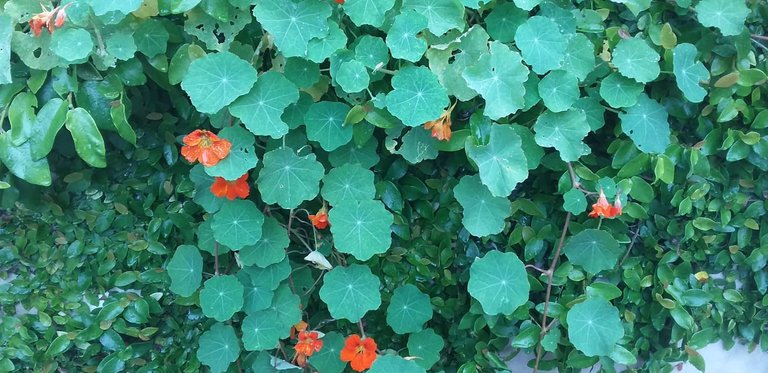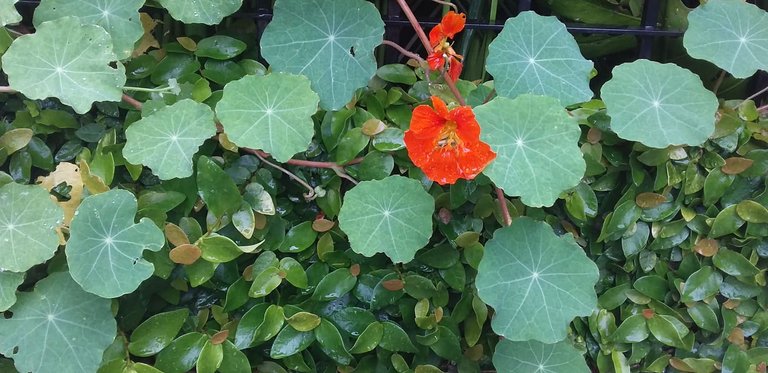Nasturtium (Tropaeolum majus) is a humble plant that dresses the gardens of many houses. It's easy to grow, the flowers are pretty and it provides good ground coverage.
This is a perfect example of edible landscaping. A plant that is beautiful and edible. What else can we ask?
Eating the "peak" on the back of nasturtium flowers is among my earliest childhood memories (together with my mom telling not to do it or we would not have plants the next year LOL). It's sweet and spicy. A perfect Spring treat.

It is considered invasive, yes, but... can you think of a better way to control a plant than make it into a dish?
I use the leaves during the whole winter in salads and pot preparations. The leaves have a strong taste, very characteristic. It reminds me of turnip. So I use them to spice up instead of as main green (think of cilantro or parsley in terms of quantities).
Once Spring starts the flowers appear and the quality of the leaves decay, so once it starts flowering, it is a good moment pick up a good amount to freeze or for canning.
One of my favorite preparations is blending the leaves with loquat fruits (it's an early spring fruit in my area), olive oil, sea salt, garlic and some chili to spice up. It makes a great spread or even a pesto if we add nuts. I make big batches and put it in jars, cover them with olive oil to avoid spoiling and they last a couple of months (not sure how long because it vanishes fast).

The flowers can be used for many dishes both sweet and salted, and can be seen in restaurants as decoration.
You can find many recipes online if you look. I have tried:
Flowers stuffed with a paste of blue cheese, cream cheese and nuts. (good, but hard to eat)
I've used them as a nice detail in butter or mayonnaise.
Added them to salads.
Added them to teas (including the ever present yerba mate tea)
I've made syrup for pancakes. (very spicy, liked it)
And one time I even made wine with it--only once, didn't love it.
A bit of science:
Garden nasturtium (Tropaeolum majus L.) - a source of mineral elements and bioactive compounds
Link: pubmed.ncbi.nlm.nih.gov/29766690
"he garden nasturtium (Tropaeolum majus L.) belongs to the family Tropaeolaceae. Native to South America it was brought to Europe in XVI century. It is a plant with numerous healing properties. Medicinal plants such as the garden nasturtium contain trace elements and bioactive compounds which can be easily absorbed by the human body. The flowers and other parts of the garden nasturtium are a good source of micro elements such as potassium, phosphorus, calcium and magnesium, and macro elements, especially of zinc, copper and iron. The essential oil, the extract from the flowers and leaves, and the compounds isolated from these elements have antimicrobial, antifungal, hypotensive, expectorant and anticancer effects. Antioxidant activity of extracts from garden nasturtium is an effect of its high content of compounds such as anthocyanins, polyphenols and vitamin C. Due to its rich phytochemical content and unique elemental composition, the garden nasturtium may be used in the treatment of many diseases for example the illnesses of the respiratory and digestive systems. High content of erucic acid in nasturtium seeds makes it possible to use its oil as treatment in adrenoleukodystrophy. It is also applied in dermatology because it improves the condition of skin and hair. More recently, the flowers of this species have been used as a decorative and edible element of some types of dishes. Aim of the review was to summarize available data concerning garden nasturtium Tropaeolum majus L."
Images: One of my walls with nasturtium. It's a good ground cover and also climbs at times.